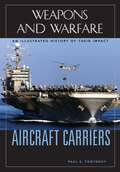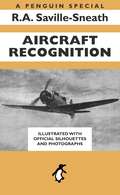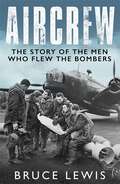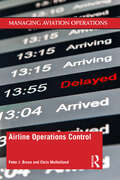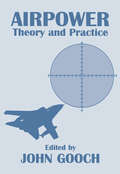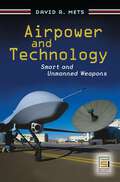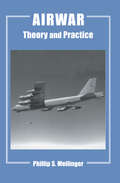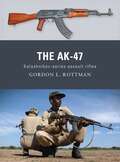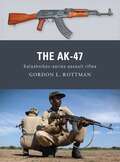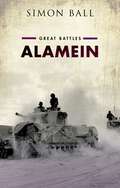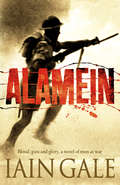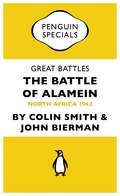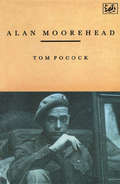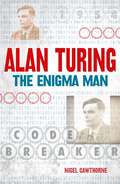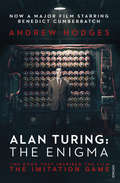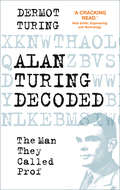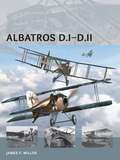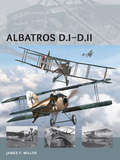- Table View
- List View
Aircraft Carriers: An Illustrated History of Their Impact (Weapons and Warfare)
by Paul E. FontenoyThis vivid volume describes the fascinating history of aircraft carriers, first deployed successfully in World War I by the Imperial Russian Navy, and indispensable to the Allied victory in World War II, now the strategic centerpiece of the world's most powerful navies.From their World War I deployment in the Black Sea by the Imperial Russian Navy, to their coming of age in World War II, to their role in recent conflicts in Vietnam, the Falklands, and the Persian Gulf, Aircraft Carriers: An Illustrated History of Their Impact charts the evolution of carrier systems both militarily and within broader political and diplomatic contexts.Covering both the ships and the planes they support, this convenient, authoritative handbook offers complete descriptions of carrier systems from all of the world's major navies—from their operational histories, strategic integration, and technological advancements, to the training of aircrew, the development of carrier command leadership, and the role of carriers as deterrents and diplomatic enforcers.
Aircraft Recognition: A Penguin Special
by R.A. Saville-SneathWhen this book was first published in 1941, aircraft recognition was far more than just a pleasant pastime; it was often a matter of life and death… This classic text provides a definitive catalogue of the aeroplanes, enemy and friendly, seen over British skies during the Second World War. R.A. Saville-Sneath set out to produce a handy classification guide, with many diagrams, a full glossary and some useful mnemonics, showing how each type of aircraft could be identified quickly and easily. The basic structures, tail units, positions of the wings and engines, and even the sounds made by the different planes, form part of the essential 'vocabulary' for distinguishing Albacores and Ansons, Beauforts and Blenheims, Heinkels, Hurricanes and Junkers, Messerschmitts and Moths, Spitfires and Wellingtons. For anyone interested in aviation the book provides a mine of information about a golden age. For those who lived through one of the most glorious episodes in the history of combat it will prove vividly evocative of those extraordinary days.
Aircrew: Dramatic, first-hand accounts from World War 2 bomber pilots and crew
by Bruce LewisA vivid, first-hand account of the tension and excitement of flying missions over Nazi GermanyThe British and American bomber crews of the Second World War often had to endure the most terrifying conditions. Not for them the glorious, all-or-nothing exhilaration of the Battle of Britain pilots - rather, the slow dwindling of courage as mission followed mission, the long, freezing, ear-shattering journey to the target, the bursting flak, the prowling night fighters. Then, if they were lucky, the long haul home, sometimes nursing a battered, barely flyable machine, often perilously short of fuel.Bruce Lewis flew in thirty-six such raids. In this book he records, in his own words and those of his fellow survivors, the events that made operational flying such a fearful experience.This is a blisteringly honest account of life for the Second World War bombers.
Airline Operations Control (Managing Aviation Operations)
by Peter J. Bruce Chris MulhollandThis text is among the first to reveal the intricacies of an airline’s Operations Control Centre; especially the thought processes, information flows, and strategies taken to mitigate disruptions. Airline Operations Control provides a deep level of description, explanation and detail into the activities of a range of highly professional and expert staff managing the ‘sharp’ end of the airline. It aims to fill a void as little is understood about this area, and very little is written for practitioners in the airline business. The book offers a comprehensive look at the make-up of the Operations Centre, its component sections, and the processes that occur both in preparing for and executing the current day’s schedules. Several chapters provide real-life scenarios and demonstrate how Operations Centres manage evolving situations – what they need to take into account, and how they need to have Plan B and Plan C ready when things don’t go right. This book is designed to deliver knowledge gains to both new and experienced aviation industry practitioners with regards to vital operational aspects. Additionally, it also offers students of air transport management a readily accessible and real-world-perspective guide to a crucial function present within every airline.
Airline Operations Control (Managing Aviation Operations)
by Peter J. Bruce Chris MulhollandThis text is among the first to reveal the intricacies of an airline’s Operations Control Centre; especially the thought processes, information flows, and strategies taken to mitigate disruptions. Airline Operations Control provides a deep level of description, explanation and detail into the activities of a range of highly professional and expert staff managing the ‘sharp’ end of the airline. It aims to fill a void as little is understood about this area, and very little is written for practitioners in the airline business. The book offers a comprehensive look at the make-up of the Operations Centre, its component sections, and the processes that occur both in preparing for and executing the current day’s schedules. Several chapters provide real-life scenarios and demonstrate how Operations Centres manage evolving situations – what they need to take into account, and how they need to have Plan B and Plan C ready when things don’t go right. This book is designed to deliver knowledge gains to both new and experienced aviation industry practitioners with regards to vital operational aspects. Additionally, it also offers students of air transport management a readily accessible and real-world-perspective guide to a crucial function present within every airline.
Airman To The Rescue: In Nadia's Defense Airman To The Rescue Shelter In The Tropics Unexpected Attraction (Heroes of Fortune Valley #2)
by Heatherly BellIt was supposed to be easy. Sarah Mcallister was going to flip her late father's house and head back to Colorado for a fresh start.
Airpower: Theory and Practice
by John GoochThe nine contributors to this volume study the rapid development of airpower during the twentieth century as well as the methodological problems involved in assessing such change.
Airpower: Theory and Practice
by John GoochThe nine contributors to this volume study the rapid development of airpower during the twentieth century as well as the methodological problems involved in assessing such change.
Airpower and Technology: Smart and Unmanned Weapons (Praeger Security International)
by David R. MetsIs there a reason for the busy citizen-leader to read about air and space history, theory, and doctrine? Yes, asserts David Mets, because without some vision of what the future is likely to bring, we enter new conflicts unarmed with any ideas and highly vulnerable to confusion and paralysis. He wrote this book to help the aspirant American leader build a theory of war and air and space power, including an understanding of what doctrine is, and what its utility and limitations are.Since its earliest days, airpower has been one of the dominant forces used by the American military. American airmen, both Navy and Air Force, have been continually striving to achieve precision strikes in high altitude, at long range, or in darkness. The search for precision attack from standoff distances or altitudes has been imperative to national objectives with expenditure of American lives, treasure, and time.This work covers the whole history of American aviation with special attention to the development of smart weapons and unmanned aerial vehicles and the influence they have had on the effectiveness of airpower. In a chronological treatment, emphasizing theory and doctrine, technology, tactics, and strategy. Mets also details both combat experience and intellectual processes, lethal and non-lethal, involved in the preparation of airpower. In addition to the narrative discussion, the work offers sidebars and feature sections that facilitate the understanding of key weapons systems and operational challenges. It also offers A Dozen-Book Sampler for Your Reading on Air and Space Theory and Doctrine. The work concludes with a brief look at information warfare and with some speculations about the future.Through this thorough consideration of the evolution of American airpower and technology, Mets provides, not only a map of the past, but a guide to future generations of airpower and its potential for keeping the United States strong and safe.
Airwar: Essays on its Theory and Practice
by Phillip S. MeilingerAccording to the author all aircrews, tacticians and those who direct them have to realise the limitations of air power during conflicts. For years opinion has differed as to whether the aircraft has altered war strategies or merely the tactics of war. This volume explores the limits of airpower.
Airwar: Essays on its Theory and Practice (Studies In Air Power Ser. #Vol. 14)
by Phillip S. MeilingerAccording to the author all aircrews, tacticians and those who direct them have to realise the limitations of air power during conflicts. For years opinion has differed as to whether the aircraft has altered war strategies or merely the tactics of war. This volume explores the limits of airpower.
The AK-47: Kalashnikov-series assault rifles (Weapon)
by Gordon L. Rottman Johnny Shumate Alan GillilandThe Kalashnikov AK-47 is the most ubiquitous assault rifle in the world, with more AK-47s and its variants in use than any other individual small arm. Created by Senior Sergeant Mikhail Kalashnikov, and first adopted by the USSR soon after World War II, its production continues to this day, with an estimated 75 million produced worldwide. This book takes a look at the complete history of the weapon, discussing its design, development, and usage, taking its story from the great armies of the Soviet Union to the insurgents and criminal gangs that often employ the weapon today.
The AK-47: Kalashnikov-series assault rifles (Weapon #8)
by Gordon L. Rottman Johnny Shumate Alan GillilandThe Kalashnikov AK-47 is the most ubiquitous assault rifle in the world, with more AK-47s and its variants in use than any other individual small arm. Created by Senior Sergeant Mikhail Kalashnikov, and first adopted by the USSR soon after World War II, its production continues to this day, with an estimated 75 million produced worldwide. This book takes a look at the complete history of the weapon, discussing its design, development, and usage, taking its story from the great armies of the Soviet Union to the insurgents and criminal gangs that often employ the weapon today.
Alamein: Great Battles (Great Battles)
by Simon BallEl Alamein was one of the pivotal battles of the Second World War, fought by armies and air forces on the cutting edge of military technology. Yet Alamein has always had a patchy reputation - with many commentators willing to knock its importance. This book explains just why El Alamein is such a controversial battle. Based on an intensive reading of the contemporary sources, in particular the extensive and recently declassified British bugging of Axis prisoners of war, military historian Simon Ball turns Alamein on its head, explaining it as a cultural defeat for Britain. Alamein is a military history of the battle - showing how different it looks stripped of later cultural excrescences. But it also shows how 'Alamein culture' saturated the post-war world, when archival sources mingled with film, novels, magazines, popular histories, and the rest of Alamein's footprint. Whether you are interested in the battle itself or its cultural afterlife, if you have an opinion about Alamein, you'll question it after reading this book.
Alamein: Great Battles (Great Battles)
by Simon BallEl Alamein was one of the pivotal battles of the Second World War, fought by armies and air forces on the cutting edge of military technology. Yet Alamein has always had a patchy reputation - with many commentators willing to knock its importance. This book explains just why El Alamein is such a controversial battle. Based on an intensive reading of the contemporary sources, in particular the extensive and recently declassified British bugging of Axis prisoners of war, military historian Simon Ball turns Alamein on its head, explaining it as a cultural defeat for Britain. Alamein is a military history of the battle - showing how different it looks stripped of later cultural excrescences. But it also shows how 'Alamein culture' saturated the post-war world, when archival sources mingled with film, novels, magazines, popular histories, and the rest of Alamein's footprint. Whether you are interested in the battle itself or its cultural afterlife, if you have an opinion about Alamein, you'll question it after reading this book.
Alamein: The Turning Point Of World War Two
by Iain GaleThe superb novelist of men at war moves into the twentieth century and World War Two, telling the story of the eleven days in the sands of North Africa that would change history forever
Alamein: War Without Hate
by Colin Smith John Bierman'Excellent ... a remarkable achievement and ought to be recognised as one of the most successful histories of the Western Desert and North African fighting yet to have appeared' John Keegan, Daily TelegraphFor the British, the battle fought at El Alamein in October 1942 became the turning point of the Second World War. In this study of the desert war, John Bierman and Colin Smith show why it is remembered by its survivors as a 'war without hate'. Through extensive research the authors provide a compellingly fresh perspective on the see-saw campaign in which the two sides chased each other back and forth across the unforgiving North African landscape.
Alan Moorehead
by Tom PocockAlan Moorehead was lionised as a literary man of action: the most famous war correspondent of the Second World War; the award-winning and best-selling author of books that vividly combin adventure and hisotry; the star travel-writer of the New Yorker; and a pioneer advocate of wildlife conservation. Drawing on Moorehead's diaries and correspondence, as well as interviews with his family and friends, Tom Pocock tells the story of a thrilling, but ultimately tragic, life.
Alan Turing: The Enigma Man
by Nigel CawthorneSpring 1940: The Battle of the Atlantic rages. Vulnerable merchant convoys are at the mercy of German U-boats controlled by a cunning system of coded messages created by a machine called Enigma. Only one man believes that these codes can be broken - mathematician and Bletchley Park cryptanalyst Alan Turing.Winston Churchill later described Turing's success in breaking the Enigma codes as the single biggest contribution to victory against Nazi Germany.Unheralded during his lifetime, Turing is now recognized as the father of modern computer science and as possessing one of the greatest minds of the 20th century. Drawing on original source material, interviews and photographs, this book explores Turing's groundbreaking work as well as revealing the private side of a complex and unlikely national hero.
Alan Turing: The Enigma
by Andrew HodgesThe official book behind the Academy Award-winning film The Imitation Game, starring Benedict Cumberbatch and Keira Knightley Alan Turing was the mathematician whose cipher-cracking transformed the Second World War. Taken on by British Intelligence in 1938, as a shy young Cambridge don, he combined brilliant logic with a flair for engineering. In 1940 his machines were breaking the Enigma-enciphered messages of Nazi Germany’s air force. He then headed the penetration of the super-secure U-boat communications. But his vision went far beyond this achievement. Before the war he had invented the concept of the universal machine, and in 1945 he turned this into the first design for a digital computer.Turing's far-sighted plans for the digital era forged ahead into a vision for Artificial Intelligence. However, in 1952 his homosexuality rendered him a criminal and he was subjected to humiliating treatment. In 1954, aged 41, Alan Turing took his own life.
Alan Turing Decoded: The Man They Called Prof
by Dermot Turing‘A cracking read. ’Nick Smith, Engineering and Technology Alan Turing was an extraordinary man who crammed into his 42 years the careers of mathematician, codebreaker, computer scientist and biologist. He is widely regarded as a war hero grossly mistreated by his unappreciative country, and it has become hard to disentangle the real man from the story. It is easy to cast him as a misfit, the stereotypical professor. But actually Alan Turing was never a professor, and his nickname ‘Prof’ was given by his codebreaking friends at Bletchley Park. Now Dermot Turing has taken a fresh look at the influences on his uncle’s life and creativity, and the creation of a legend. He discloses the real character behind the cipher-text, answering questions that help the man emerge from his legacy: how did Alan’s childhood experiences influence him? How did his creative ideas evolve? Was he really a solitary genius? What was his wartime work after 1942, and what of the Enigma story? What is the truth about the conviction for gross indecency, and did he commit suicide? In Alan Turing Decoded, Dermot’s vibrant and entertaining approach to the life and work of a true genius makes this a fascinating and authoritative read.
Alanbrooke War Diaries 1939-1945: Field Marshall Lord Alanbrooke
by Lord AlanbrookeThe first complete and unexpurgated edition of the war diaries of Field Marshall Lord Alanbrooke - the most important and the most controversial military diaries of the modern era.Alanbrooke was CIGS - Chief of the Imperial General Staff - for the greater part of the Second World War. He acted as mentor to Montgomery and military adviser to Churchill, with whom he clashed. As chairman of the Chiefs of Staff committee he also led for the British side in the bargaining and the brokering of the Grand Alliance, notably during the great conferences with Roosevelt and Stalin and their retinue at Casablanca,Teheran, Malta and elsewhere. As CIGS Alanbrooke was indispensable to the British and the Allied war effort. The diaries were sanitised by Arthur Bryant for his two books he wrote with Alanbrooke. Unexpurgated, says Danchev, they are explosive. The American generals, in particular, come in for attack. Danchev proposes to centre his edition on the Second World War. Pre and post-war entries are to be reduced to a Prologue and Epilogue). John Keegan says they are the military equivalent of the Colville Diaries (Churchill's private secretary), THE FRINGES OF POWER. These sold 24,000 in hardback at Hodder in 1985.
Alaska Mountain Rescue: A Cold Case Mystery (A K-9 Alaska Novel #2)
by Elizabeth HeiterCatching a kidnapper takes teamwork
Albatros D.I–D.II (Air Vanguard)
by Peter Bull Henry Morshead Simon Smith James F. MillerIn 1916 German aerial domination had been lost to the French and British fighters. German fighter pilots requested an aircraft that was more powerful and more heavily armed, and the Albatros design bureau set to work on what was to become an iconic aircraft design. By April 1916, they had developed the Albatros D.I, that featured the usual Albatros semi-monocoque wooden construction with a 160hp Mercedes engine and two forward-firing machine guns. Alongside the development of the D.I, Albatros had also designed and built a second machine that was similar to the D.I – the Albatros D.II. Although there were several external differences between the two aircraft, it is important to note that these machines evolved simultaneously and that the D.II was not the result of post-combat feedback from D.I pilots. With the inclusion of these aircraft into their reorganized air force, Germany was able to regain control of the skies by autumn 1916. Along with the later designs they inspired, the Albatros D.I and D.II were instrumental in allowing the Germans to prosecute their domination through 'Bloody April' and well into the summer months that followed.
Albatros D.I–D.II (Air Vanguard #5)
by Peter Bull Simon Smith Mr Henry Morshead James F. MillerIn 1916 German aerial domination had been lost to the French and British fighters. German fighter pilots requested an aircraft that was more powerful and more heavily armed, and the Albatros design bureau set to work on what was to become an iconic aircraft design. By April 1916, they had developed the Albatros D.I, that featured the usual Albatros semi-monocoque wooden construction with a 160hp Mercedes engine and two forward-firing machine guns. Alongside the development of the D.I, Albatros had also designed and built a second machine that was similar to the D.I – the Albatros D.II. Although there were several external differences between the two aircraft, it is important to note that these machines evolved simultaneously and that the D.II was not the result of post-combat feedback from D.I pilots. With the inclusion of these aircraft into their reorganized air force, Germany was able to regain control of the skies by autumn 1916. Along with the later designs they inspired, the Albatros D.I and D.II were instrumental in allowing the Germans to prosecute their domination through 'Bloody April' and well into the summer months that followed.
